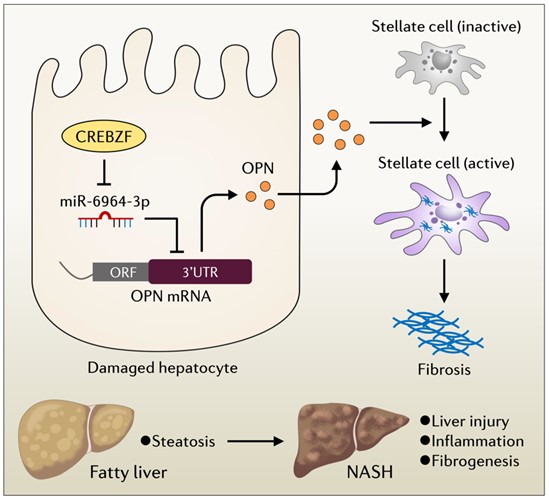Scientists Identify Novel Mechanism of Liver Fibrosis and NASH via CREB/ATF bZIP Transcription Factor-mediated Production and Secretion of Osteopontin
Nonalcoholic steatohepatitis (NASH) is characterized by the presence of persistent liver injury, chronic inflammation and dysfunctional liver fibrosis. Progressive fibrosis is the hallmark of NASH disease progression and liver fibrosis is the leading determinant of long-term mortality in NASH patients.
The exact mechanisms that govern the progression of NASH remain poorly defined and there are currently no approved pharmacological therapies for NASH, highlighting the urgent need to develop effective therapeutic strategies for this condition.
CREB/ATF bZIP transcription factor (CREBZF) has been emerged as an important regulator in the control of hepatic lipogenesis via repressing Insig and liver regeneration via inhibiting STAT3 (Zhang F, et al, Hepatology 2018; Hu Z, et al, Hepatology 2020, Cui A, et al, Diabetes 2021). However, whether CREBZF plays a role in regulating liver fibrosis and NASH is unknown.
In corporation with Dr. XU Yong at the Affiliated Hospital of Southwest Medical University, a team of scientists led by Professor LI Yu from Shanghai Institute of Nutrition and Health, Chinese Academy of Sciences revealed that CREBZF deficiency in hepatocytes alleviated NASH phenotypes, including decreased hepatocyte injury, inflammation and fibrogenesis, in mice fed with AMLN diet. Moreover, hepatic overexpression of CREBZF in mice exacerbated NASH phenotypes.
These studies characterize CREBZF as a liver fibrosis checkpoint that promotes hepatocyte injury and exacerbates NASH progression. RNA sequencing (scRNA-seq and bulk RNA-seq) of NASH livers of mice, together with cell coculture assays, revealed that an extracellular matrix protein osteopontin (OPN) is positively regulated by CREBZF, and the CREBZF-OPN axis mediates the crosstalk between hepatocytes and HSCs in NASH progression. Mechanistically, inhibition of miR-6964-3p mediates CREBZF-induced OPN expression in hepatocytes. Adeno-associated virus (AAV)-mediated rescue of OPN restored HSC activation, liver fibrosis and NASH progression in CREBZF deficient mice. Importantly, expression levels of CREBZF are increased in livers of diet-induced NASH mouse models and humans with NASH, which are also positively corelated with increased expression of OPN in NASH.
This study demonstrates that osteopontin signaling by CREBZF represents a previously unrecognized intrahepatic mechanism that triggers liver fibrosis and contributes to the severity of NASH, and targeting CREBZF may represent a therapeutic strategy for the treatment of liver fibrosis and NASH.
This work was published online in Hepatology on January 3rd, 2023, as a research article entitled “Intrahepatic osteopontin signaling by CREBZF defines a checkpoint for steatosis-to-NASH progression”. This study was funded by grants from Ministry of Science and Technology of China, National Natural Science Foundation of China, China Postdoctoral Science Foundation, and Luzhou-Southwest Medical University cooperation project.

The proposed model for hepatic CREBZF as a checkpoint in regulating the progression of nonalcoholic steatohepatitis. (Image provided by Dr. LI Yu's laboratory)
Media Contact:
WANG Jin
Shanghai Institute of Nutrition and Health,
Chinese Academy of Sciences
Email: wangjin01@sinh.ac.cn
Web: http://english.sinh.cas.cn/
